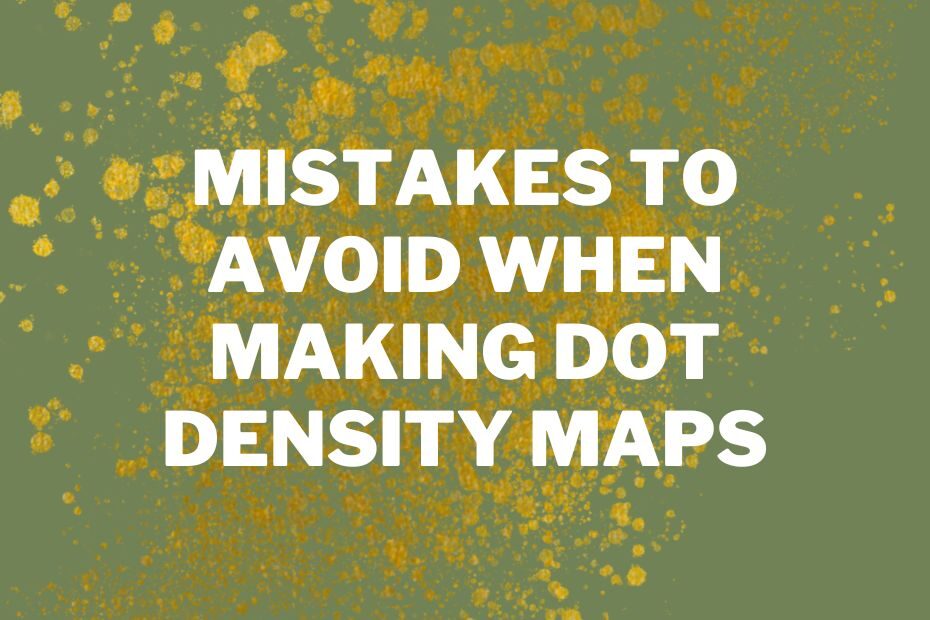Dot density maps are a powerful tool for visualizing spatial data. They are commonly used in fields like geography, demography, and ecology, to display the density of a particular phenomenon in a given area. However, creating an effective dot density map requires a certain level of expertise and attention to detail. In this article, we’ll take a look at some common mistakes to avoid when making dot density maps.
Some common mistakes to avoid when making dot density maps include using too many colors, not normalizing data, using inappropriate dot sizes, ignoring spatial autocorrelation, failing to consider map scale, and not providing contextual information.
7 Most Common Mistakes To Avoid When Making Dot Density Map
Dot density maps are a popular way of displaying data in a spatial context. They are commonly used to show the density of a particular phenomenon, such as population density or crime rate, in a given area.
However, creating an effective dot density map can be tricky, and there are several common mistakes that people make. We’ll take a look at some of these mistakes and how to avoid them.
Mistake #1: Not Considering the Scale
One of the most important factors to consider when making a dot density map is the scale. The scale determines the level of detail that is shown in the map. If you choose a scale that is too small, your map may be cluttered with dots, making it difficult to read.
On the other hand, if you choose a scale that is too large, you may lose important details in the map. Therefore, it’s essential to choose an appropriate scale that shows enough detail while keeping the map readable.
Mistake #2: Using Inaccurate Data
Another common mistake when making dot density maps is using inaccurate data. If the data you use to create the map is incorrect, your map will be misleading. Before creating a dot density map, ensure that the data is accurate and up-to-date.
Mistake #3: Using Too Many Categories
Using too many categories is another common mistake when making dot density maps. If you use too many categories, the map can become too complex and difficult to read. It’s recommended to use no more than 5-7 categories in a dot density map.
Mistake #4: Not Using a Proper Legend
A proper legend is essential for any map, and dot density maps are no exception. The legend should clearly explain what the dots represent and how they are classified. It’s also important to ensure that the legend is visually appealing and easy to read.
Mistake #5: Ignoring Spatial Autocorrelation
Spatial autocorrelation is a phenomenon where nearby areas tend to have similar values for a particular variable. Ignoring spatial autocorrelation can lead to misleading conclusions and a poorly designed map. It’s important to take spatial autocorrelation into account when designing a dot density map.
Mistake #6: Using Inappropriate Symbol Sizes
Using inappropriate symbol sizes is another common mistake when making dot density maps. If the symbol sizes are too small, the map may be difficult to read, and if they are too large, the map may be cluttered with dots. It’s important to choose appropriate symbol sizes based on the scale of the map and the density of the phenomenon being represented.
Mistake #7: Not Considering the Audience
Finally, not considering the audience is another common mistake when making dot density maps. The map’s design and the level of detail shown should be appropriate for the intended audience. For example, a map designed for policymakers may need to be more detailed than a map designed for the general public.
Conclusion
In conclusion, creating an effective dot density map requires careful consideration of several factors. Not considering the scale, using inaccurate data, using too many categories, not using a proper legend, ignoring spatial autocorrelation, using inappropriate symbol sizes, and not considering the audience are common mistakes to avoid. By keeping these factors in mind, you can create a dot density map that effectively communicates your message and helps you make informed decisions based on the data.
FAQs Related To : Mistakes To Avoid When Making Dot Density Maps
What is a dot density map?
A dot density map is a type of thematic map that uses dots to represent data values.
What is the purpose of a dot density map?
The purpose of a dot density map is to visualize data and identify spatial patterns.
Why is it important to provide contextual information in a dot density map?
Providing contextual information helps users interpret the map and make informed decisions based on the data.
